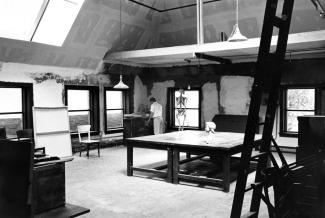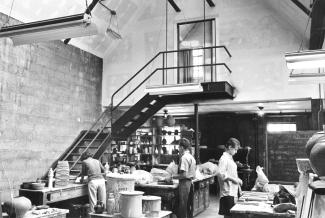
The visual arts emerged as a curricular option at the University of Chicago in the mid 1900’s, when the University acquired Lorado Taft’s Midway Studios. The visual arts were first available as an extracurricular respite from the intensity of scholarly pursuits. This attitude towards the arts was endemic to the period, coming from a post-Enlightenment modality that understood there to be societal and individual betterment to be had through engagement with the arts: enriched by their cultural experience as makers and viewers of art, students would become better human beings. Art making was seen as an avenue for personal expression and recreation. Studio courses were taught under the umbrella of The Department of Art (the name of which was later and more accurately changed to The Department of Art History). Midway Studios housed much of the Department’s teaching, although classes were also held in Cobb Hall through the 1980’s.
Beginning in 1950, students had the option to take a master’s degree focused either on the History or the Practice of Art. Even for those who concentrated on making art, the degree awarded was an MA rather than an MFA. Six years later in 1956, the University awarded its first Master of Fine Arts in the Practice of Art.

In 1970 the studio art program solidified as a semi-autonomous committee, albeit still governed by the Chair of the Art History Department. The first Director of the committee housed at Midway Studios was Hall Hayden, who headed the Department until the 1970’s, when Tom Mapp assumed this role. He and Bob Peters were hired from the School of the Art Institute and charged with bolstering this disciplinary area. Lecturers and adjunct faculty through these years included Ruth Duckworth, Vera Klement, and Virginio Ferrari. In 1977 the committee was named the Committee on Art and Design, although it continued to be academically and administratively housed within the Department of Art History.
The Committee on Art and Design (CAD) was modeled on other committees in the Division of the Humanities and the Division of the Social Sciences that had a long history at the University, and this allowed faculty with shared interests in different departments to create units that met perceived intellectual needs not met by the departments themselves. In addition to the studio faculty, CAD was constituted with additional faculty from other departments, including English, Philosophy, Anthropology and Art History.
CAD was different from other interdisciplinary committees in that it always had a graduate program: the MFA program. At this time it shared a common Chair with the Art History Department; the Art History Professor Charles Cohen served as Chair for nine of CAD’s first twelve years of existence.

In 1996, CAD became the Committee on the Visual Arts (CoVA). This was more than a name change, since the Committee now became entirely autonomous with its own chair and its own budget separating completely from the Department of Art History. Charles Cohen was lobbied by the studio faculty and agreed to serve as Co-Chair for the newly independent CoVA from 1996 – 2005.
In 2005 Laura Letinsky became the first studio faculty member to serve as Chair of CoVA, having Co-Chaired with Cohen 2002-2005. Letinsky, who was hired in 1994, has heavily influenced the shaping of the Department as it has developed into its present form, changing what had been a Committee to a full-fledged department—the Department of Visual Arts (DoVA)—which represented another step in our progression towards the flourishing status of the current program.
In the wake of CoVA’s transition to an autonomous department in 2006, several faculty members retired and several significant hires were made, providing the Department of Visual Arts with a new core faculty—all of whom command attention from scholars, curators, and audiences nationally and internationally. These hires included Catherine Sullivan in 2006, and David Schutter and Jason Salavon in 2007; all three received tenure in 2013 and 2014. Geof Oppenheimer was hired as a Harper Schmidt Fellow in the College in 2007 and as an Associate Professor of Practice in 2011. Matthew Jesse Jackson was hired as a joint appointment between DoVA and Art History in 2005 and awarded tenure in 2010. Next came the hiring of William Pope.L in 2010 followed by Jessica Stockholder in 2011, who was hired as Chair of the Department, bringing further stability and renown to DoVA along with the hire of Theaster Gates in 2014 who had been affiliated with the University for some time.

The emergence of the stand-alone Department of Visual Arts was fueled over the years by the interest and support of many faculty members across the University of Chicago, who engaged in extended dialogue about the role of the arts at the University including Bill Brown, W.J.T. Mitchell, Christine Mehring and Rachel Cohen. Their combined effort and enthusiasm led to the building of the Logan Center for the Arts, which opened at the end of 2012 and has served as DoVA’s home ever since.
In 2018, Matthew Jesse Jackson assumed the role Chair of DoVA, with a new wave of faculty hires coming soon afterwards including Julia Phillips in 2018, Mari Eastman in 2023, and most recently Anna Martine Whitehead in 2025. The department’s undergraduate and graduate programs have excelled as a model for interdisciplinary research and art-making within the University and beyond. Faculty and students of DoVA continue to thrive in this intellectual and creative environment and are exceptionally active, exhibiting and publishing along with alumni who have gone on to exhibit and teach nationally and internationally.
